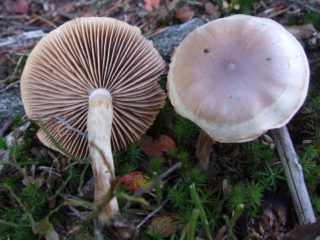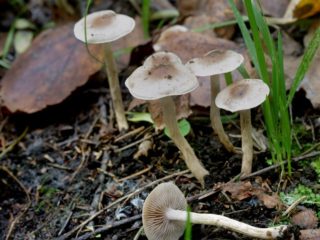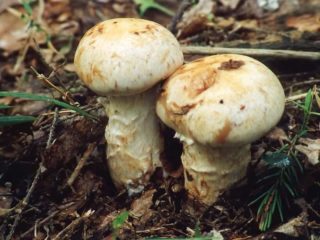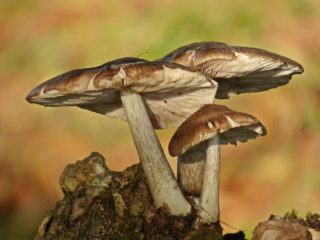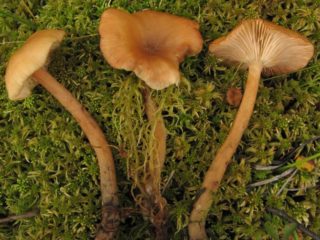Content
Hebeloma sticky (Valuy false) is a representative of the Spiderweb family, which is widespread in the Northern Hemisphere. The name has many synonyms: a horseradish mushroom, a poisoned pie, a fairy cake, etc. Despite its rather attractive appearance, it belongs to the weakly poisonous.
What does Hebeloma sticky look like?
The diameter of the gummy cap can be from 3 to 10 cm. Its color is yellowish-brown, with a noticeable darkening in the center. In young fruiting bodies, it has a convex cushion shape. With age, its surface flattens, a wide tubercle rolls over it.
At an early age, the cap is covered with mucus, over time it becomes dry and shiny. Depending on external factors, the color can vary from grayish to reddish brown. The edges of the cap are slightly bent.
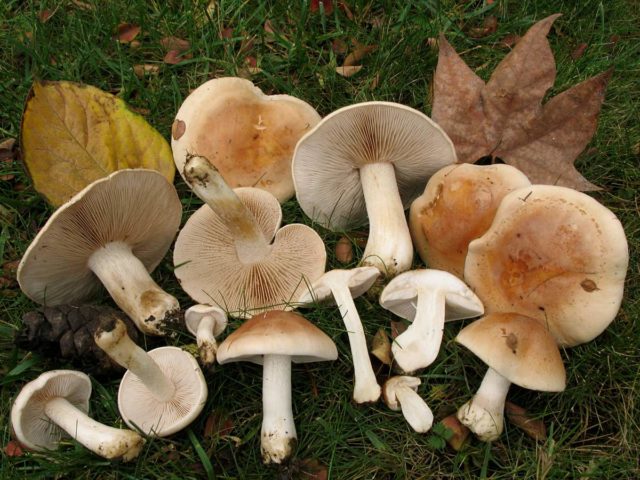
Instances of hebeloma sticky of different ages
The leg has a cylindrical shape. Its diameter is 1-2 cm, and its length is from 3 to 10 cm. At first it is white, but with age it becomes yellowish, then brown. In addition, in mature specimens, the leg is noticeably thickened from below. Inside it is hollow, the outer covering is scaly.
The hymenophore is lamellar, its color is the same as that of the leg: at first it is whitish, over time it becomes yellow or brown. The plates have small indentations where liquid droplets form in wet weather. It has a brown color due to the presence of spores.
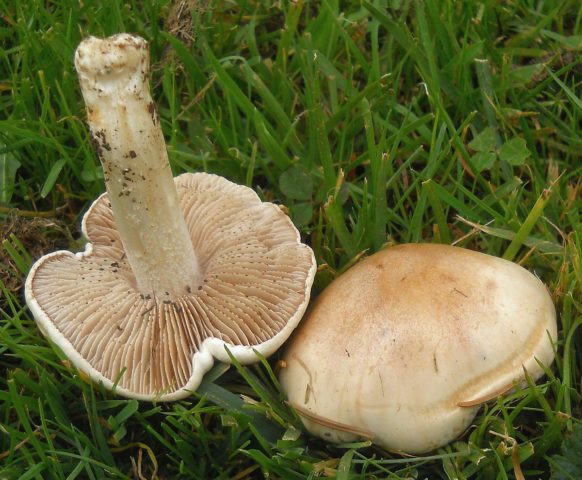
Drying liquid causes the hymenophore to darken.
The flesh is white; in old specimens of gummy sticky, it is yellowish. Its layer is thick and the consistency is loose. The taste of the pulp is bitter, the smell is pungent, reminiscent of a radish.
Doubles of hebeloma adhesive
In the Webinnikov family, there are about 25 genera and more than 1000 species. Among such a variety, Hebeloma sticky has many twins similar to it. The most common are three types.
Coal-loving Gebeloma
Prefers to grow on forest fire sites. It is smaller than the false value. The diameter of the cap does not exceed 2 cm, and the length of the stem is 4 cm. Another important difference is the color. The color of the cap is brown in the center, white and yellow around the perimeter.
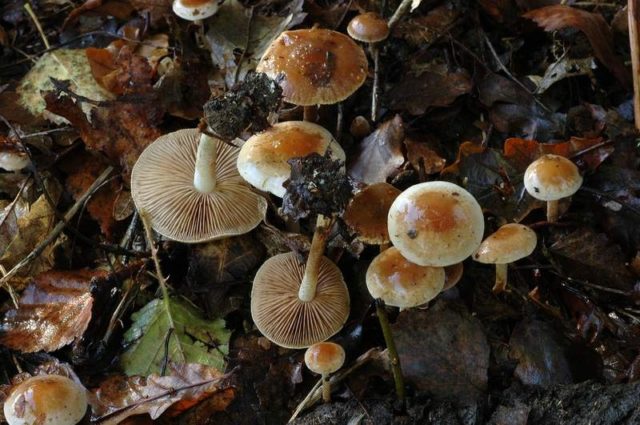
Gebeloma coal-loving is covered with mucus throughout the entire life cycle
This mushroom is not poisonous, but it is inedible due to its bitter taste. At the same time, the smell of the pulp is pleasant.
Gebeloma belted
It has a hat with a diameter of up to 7 cm and a relatively long stem - up to 9 cm. The color practically repeats the color of the false false, only the old specimens have differences (the hebeloma belted has a light brown tint). The growing areas of the varieties are almost completely the same.
The main difference to be guided by when identifying this species is the thinner layer of pulp on the cap. Another important difference is the light hymenophore. It does not form dark spots, since the spores of this species are white.

Outwardly, a young hebeloma belted is very similar to Valui false
Until now, there is no unequivocal opinion about the suitability of this species for food, therefore, in the reference books, it is defined as inedible.
Mustard Hebeloma
A large species with a monochromatic cap. Its diameter sometimes reaches 15 cm. The length of the leg varies from 10 to 15 cm. The color is light brown or cream. With age, the mushroom becomes mustard, which is where its name comes from. There are many differences in the species, but the external similarity is manifested due to the shape of the fruiting body. In addition, mushrooms have the same habitat and ripening time.
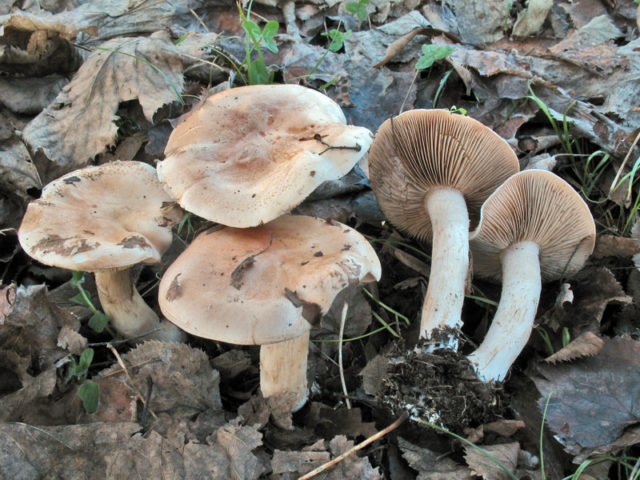
Mustard gebeloma is larger than false Valui
The main difference is the absence of mucus at any age of the fungus. The skin on the cap is shiny. In addition, this variety has a denser pulp and a leg without a cavity. The smell and taste are identical to the gummy glue. The hymenophore is white, its plates are even, and they have no grooves.
Where does hebeloma sticky grow
Distributed in the temperate climate of the Northern Hemisphere throughout Europe and Asia - from the Bay of Biscay to the Far East. It is ubiquitous in Canada and the northern United States. It can be found in both the extreme northern and southern regions. Cases of finding mushrooms in the regions of the Arctic Circle and in the south of Central Asia were recorded. It was listed in Australia. Not found in Africa and South America.
It grows in both coniferous and deciduous forests. It can be found in glades, meadows, glades, in parks. Despite the fact that it forms mycorrhiza with all types of trees, prefers deciduous conifers - oak, birch, aspen. The nature of the soil, as well as its moisture or shade of the area, do not play a role.
Fruiting occurs in late summer and lasts until November. In regions with warm winters, the fungus is found even in December and January. Often forms rings.
Is it possible to eat ghebel sticky
Hebeloma sticky belongs to inedible mushrooms. Some sources indicate its weak toxicity. Modern mycology still cannot identify which of the toxic substances included in the false valui cause poisoning.
Poisoning symptoms are standard:
- colic in the abdomen;
- diarrhea;
- vomiting;
- headache.
The first signs appear a few hours after eating the mushroom. Help with poisoning includes cleansing the stomach and intestines by taking emetics and laxatives, and drinking plenty of warm drinks. The use of sorbents (activated carbon) is recommended.
Conclusion
Hebeloma sticky (Valui false) is a weakly poisonous mushroom from the Spiderweb family, found everywhere in the temperate climate of Eurasia and North America. A hardy and unpretentious species spreads from the hot southern regions to the Far North. It is able to form mycorrhiza with almost all types of trees and can grow on soils of any composition and acidity.
